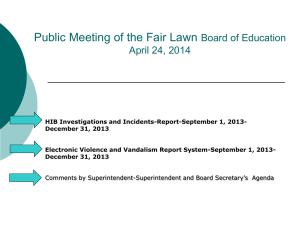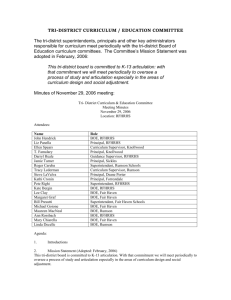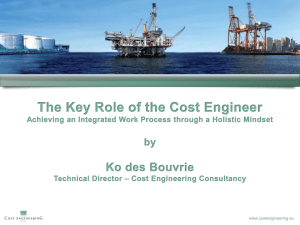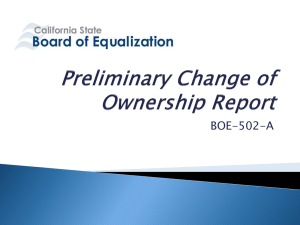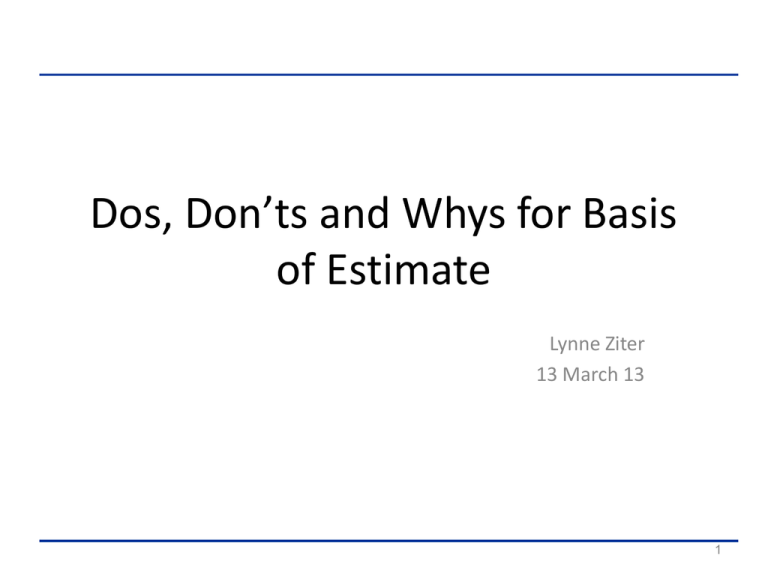
Dos, Don’ts and Whys for Basis
of Estimate
Lynne Ziter
13 March 13
1
Agenda
Business System
DCMA impact
Rule
WHAT
is a BOE?
WHY is it necessary?
WHO reviews it?
WHAT is it used for?
BOE basic elements:
Header
Task Description
Basis Of Estimate
Bid
−Historical similar task performance data
−Parametric data
−Firm Quotation
−Level of Effort
−Engineering Estimate
Detail
EXAMPLES of the King and the Frog (as reviewed by the Prince)
2
Business System Rule
3
Business Systems
•
•
•
•
•
•
Accounting System
Estimating System
Purchasing System
Earned Value Management System (EVMS)
Material Management and Accounting System
Property Management System
4
Business Systems: DFARS 252-242-7005
•
•
•
•
•
Initial Proposal Dec. 3, 2010.
Interim Rule with request for comments issued May 11, 2011.
Final Rule effective February 24, 2012.
Applies to all CAS –covered contracts.
Significant deficiency in any system requires ACO to reduce payments
on covered contracts by 5% and if multiple deficiencies, max
withholding of 10%.
5
Estimating System: DFARS 252-215-7002
• “Estimating system” means the Contractor's policies, procedures, and
practices for budgeting and planning controls, and generating estimates
of costs and other data included in proposals submitted to customers in
the expectation of receiving contract awards.
• “Significant deficiency” means a shortcoming in the system that
materially affects the ability of officials of the Department of Defense to
rely upon information produced by the system that is needed for
management purposes.
6
System Requirements of an Adequate Estimating System
• The Contractor shall disclose its estimating system to the Administrative
Contracting Officer (ACO), in writing.
• An estimating system disclosure is acceptable when the Contractor has provided
the ACO with documentation that—
(i) Accurately describes those policies, procedures, and practices that the
Contractor currently uses In preparing cost proposals; and
(ii) Provides sufficient detail for the Government to reasonably make an
informed judgment regarding the acceptability of the Contractor's estimating
practices.
• The Contractor shall—
(i) Comply with its disclosed estimating system; and
(ii) Disclose significant changes to the cost estimating system to the ACO
on a timely basis.
• The Contractor’s estimating system shall provide for the use of appropriate
source data, utilize sound estimating techniques and good judgment, maintain a
consistent approach, and adhere to established policies and procedures.
7
Characteristics of an Adequate Estimating System
• Establish clear responsibility for preparation, review, and approval of cost
estimates and budgets.
• Provide a written description of the organization and duties of the personnel
responsible for preparing, reviewing, and approving cost estimates and budgets.
• Ensure that relevant personnel have sufficient training, experience, and guidance
to perform estimating and budgeting tasks in accordance with the Contractor's
established procedures.
• Identify and document the sources of data and the estimating methods and
rationale used in developing cost estimates and budgets.
• Provide for adequate supervision throughout the estimating and budgeting
process.
• Provide for consistent application of estimating and budgeting techniques.
• Provide for detection and timely correction of errors.
• Protect against cost duplication and omissions.
• Provide for the use of historical experience, including historical vendor pricing
information, where appropriate.
8
Characteristics of an Adequate Estimating System
•
•
•
•
•
•
•
•
Require use of appropriate analytical methods.
Integrate information available from other management systems.
Require management review, including verification of compliance with the company's
estimating and budgeting policies, procedures, and practices.
Provide for internal review of, and accountability for, the acceptability of the
estimating system, including the budgetary data supporting indirect cost estimates
and comparisons of projected results to actual results, and an analysis of any
differences.
Provide procedures to update cost estimates and notify the Contracting Officer in a
timely manner throughout the negotiation process.
Provide procedures that ensure subcontract prices are reasonable based on a
documented review and analysis provided with the prime proposal, when practicable.
Provide estimating and budgeting practices that consistently generate sound
proposals that are compliant with the provisions of the solicitation and are adequate
to serve as a basis to reach a fair and reasonable price.
Have an adequate system description, including policies, procedures, and estimating
and budgeting practices, that comply with the Federal Acquisition Regulation and
Defense Federal Acquisition Regulation Supplement.
9
DCMA ‘Trip Wires’
Primary Trip Wires
BEI
System
Indicators
Baseline
Indicators
SPI
<.95
Secondary Trip Wires
Contract
CPLI
CPI/TCPI
Mods
10%
10%
Baseline
Revs
5%
System Indicator (Primary)
• EV Certification withdrawn
• Major Subcontractors do not hold EV
Certification
• DCMA Level 3 or higher CAR’s issues
New Schedule Metrics
• Baseline Execution Index – used to
measure efficiency with which actual work has
been accomplished when measured against the
plan
Baseline Indicators (Primary)
• Was initial review conducted within 180 days
• On-going reviews triggered by major
modifications and/or OTB
• Outcome of the reviews
• Is scope fully & mutually understood
• Does the baseline capture all work
• Is MR adequate given expected risk
• Does the contract have an executable ,
time phased baseline
Critical Path Length Index - used to measure
the realism of completing the contract on time.
Standard EV Metrics – SPI, CPI, TCPI
Revision Metrics
• PMB Revisions – changes to monthly timephased PMB value of 5%
• Contract Mods – contract mod to original
base value of 10% or more
10
Provided BOE (Simple Government Guidance)
YELLOW requires:
• Previous experience but no actual detail
data provided
CATEGORY
Unsupported Estimate
Based on Specific Experience
CHARACTERISTICS
“Engineering Judgement”
“Company Experience”
No Substantive Supporting Information
Judgement, Including Qualification of “Judge”
Previous Project Experience
- Identify Project(s), but Provide No Actual Data
Cost Estimating Relationship
- No Supporting Information
Scaled Actuals, Work Not
Shown
Use Historical Actual Data
- General Description of Scaling, but no Details
Scaled Actuals, Work Shown
Historical Actual Data
Justify, In Detail, the Scaling Factors Used
Multiple Scaled Actuals
Same as above, but Cite Multiple Sources
Cost Estimating Relationship
- Document Model / Inputs
COLOR CODE
GRADING
• Analogous experience provided but no
actual detail task and cost data.
• Scaling factors defined but not
supported by justification.
RED
GREEN requires:
YELLOW
YELLOW
GREEN
BLUE /
GREEN
• Detailed task breakdown
• Detailed and thorough comparison of
analogous and estimated tasks
• Justification is thorough for the scaling
factor(s) derived to account for estimate
task variances from the analogous task
BLUE requires:
• Multiple analogous historical tasks and
cited and analyzed
• Multiple sources are provided to
validate the integrity of the relationship
between estimate details and past
experience tasks and performance
actuals
11
Responsibility & Risk
Accepting controlled risk typically means the difference
between “winning” and “loosing”. What does controlled
mean?
•Every BOE author is responsible to review and
challenge proposed task approaches to minimize
execution cost.
•Ensure that all key assumptions and risks accepted are
captured in the program risk register, and mitigation
planning has management visibility.
•Continuously evaluate options planning and executing
tasks in more cost effective ways.
•Continuously work with interfacing work tasks to
eliminate redundancies and comply with dependencies
requirements.
12
Results of a Recent DCMA Audit
• DCMA has staffed the EVM Center of Excellence
• Deep Dive DCMA Review teams are targeting programs and
Companies across the industry based on Trip Wire Metrics
• Bad EV review could result in loss of approved EV system which can
result in:
– Stoppage of progress payments
– Inability to bid on major contracts requiring EV
– Significant Company internal cost to gain approval back
• Recent Industry review results have caused the DCMA teams to
question
– The ability of current management processes and practices to
assess emerging issues of cost & schedule in a timely manner
– The accuracy and validity of the PMB data
– The adequacy of the Estimate At Complete information
– Commitment of the Company to use EV as a management
process
– Adequacy employees training to understand the need for EVMS,
what has changed, and the rules under which to execute it.
The lack of EV culture can lay the foundation for failure
13
Basis of Estimate – WHAT is it?
BOE = Explanation & justification of
your estimate to do the work.
Documents
the thought process, approach, and
rationale used to arrive at the estimate being
proposed
Explains
the logic, rationale method, data and
calculations used to estimate the resources
required to perform the work
14
Basis of Estimate - WHY Is It Necessary?
External Solicitations may require it.
New opportunity solicitation responses
Existing contract new work scope control
Internal Management may require it.
Evaluate bids before committing the company
Review program baseline setting or updates
Does your process require BOEs?
Would you do them if it were not “required”? WHY?
15
Basis of Estimate – WHO Reviews it?
External (solicitation response) Someone who:
Does not work for your company
Does not necessarily understand your products or
business practices
Does not always understand your job
Will decide whether your BOE is justifiable and
awardable
Will negotiate award value based upon your BOE
Internal (baseline or estimate justification) Someone who:
Does work for your company
Does understand your products or business practices
Does not always understand your job
Will help decide your baseline budget
Food for thought . . WHICH one is more difficult to do?
16
Basis of Estimate – WHAT Is It Used For?
To evaluate the Cost Reasonableness and
Realism of your estimate.
Realism – Compatibility of estimate with scope (as
defined in the estimate Task Statement)
Reasonableness – Justification for estimate
development methodology, and Completeness and
Accuracy of the mathematics applied.
17
Basic BOE Components (format can vary greatly)
1. Header Information
2. Task Description
3. Basis of Estimate
4. Bid Detail
18
Basic BOE Components - Header
1.Header Information
WBS or Task ID: Where this estimate
fits/maps to the CWBS
Period of Performance (Start / End):
When this activity will happen within the
program schedule – and for how long
VERY easy way for auditor to check bid validity
19
Basic BOE Components - Task Description
2.Task Description
WHY is this task being done?
Do not do work that is not required,
unless authorized by stakeholders with
the authority to do so.
Reference “driving” document (Spec, SOW, etc.)
WHAT will be done? Provide a complete
& clear explanation of the tasks included.
EQUALLY important to state the tasks NOT included.
Provide detail to fully describe the tasks to be performed.
Provide detail to a level that bid hours/task will be small.
ASSUMPTIONS for this estimate? Identify
assumptions that the estimate is based on.
Can lead directly to identification and mitigation of risk.
PLAN INTEGRATION: Define inputs and
outputs of tasks when appropriate.
Avoids requirement
misinterpretations, and
clarifies the “gray” areas.
The more detail . . . the
better the plan, the
estimate, and the ultimate
performance.
Defines boundary
conditions that can impact
the estimate (GFE receipt,
IRAD product arrival,
number of re-tests, etc.
Key tasks & deliverables should align with schedule .
Assists in plan and
IMS integration.
This information defines the work (tasks) you are committing to do
20
Basic BOE Components - Basis of Estimate
3. Basis Of Estimate
RATIONALE: HOW you derived the estimate
to execute the effort described in the Task
Description section.
TYPICAL RATIONALE TYPES:
Historical Program(s) task and cost data.
Historical Program or Organizational Productivity
parametric data
Firm Quotation (from a subcontractor or supplier)
Level of Effort
Engineering Estimate
Most
Desired
Least
Desired
21
Basic BOE Components - Basis of Estimate cont’d
3.Basis Of Estimate
A. Historical Programs (s) task and cost data – comparison of estimated scope to
analogous work previously performed.
ANALAGOUS PROGRAM SELECTION
- WHY program selected is validly comparable to estimated effort
- Detailed comparison of program and tasks to estimated effort
- Can be directly analogous “factored” (scaled to reflect differences)
RELATIVE FACTOR – Adjusted actuals from similar task.
- Compares complexity (or other characteristic) to analogous task
- Factor selection methodology (detail of rationale & reasonableness)
RELATIVE LABOR MIX -
- Detailed rationale for how accounted for in the estimate (compare
historical program mix to estimate mix, with rationale)
- Discuss hours & equivalent heads, not headcount or staffing levels.
22
Basic BOE Components - Basis of Estimate cont’d
3.Basis Of Estimate
B. Historical Programs or Organizational Productivity Data
HISTORICAL PRODUCTIVITY DATA (parametric estimates)
- Functional productivity data (SE, SW, HW, etc.)
- Rate based (Rqmts/Hr, ELOC/Hr, Hrs/Drawing, etc.).
- Calibrated by historical experience
SIMILARITY DETERMINATION
- Select similar programs (products, technology, etc.)
RANGE DETERMINATION
- Forecast position where program estimate should fall within
the family of similar program productivities (at estimate
launch).
- Show position where program estimate productivities do fall
within the family of similar program productivities (as estimate
review).
23
Basic BOE Components - Basis of Estimate cont’d
3.Basis Of Estimate
c. Firm Quote
D. Level Of Effort
Most common guidance is that LOE estimate value should
not exceed 15-20% of project value (they are difficult to
manage and mask performance data).
Segregate discrete tasks - move definable/discrete tasks
and products out of the LOE task whenever feasible)
Analogous LOE work used for estimate basis of LOE tasks:
Must detail the analogous tasks to significant detail, and
provide direct correlation to corresponding estimate
tasks.
Must examine the skill mix of the analogous and current
estimate task, and explain how analyzed and reflected in
the estimate.
24
Basic BOE Components - Basis of Estimate cont’d
3.Basis Of Estimate
E. Engineering Estimate
Not desired. Only used when other methods are impractical
and historical data is not available (least preferred method)
Educated guess not backed by documented previous
experiences.
Guidance:
- Need step-by-step explanation of activities to be
performed
- Break activities into small tasks, with small number of hours
for each (easy to understand)
- Caution . . Credibility is very difficult to achieve because the
detail is not based on any quantitative program or
organizational measures or experience.
25
Basic BOE Components - bid Detail
4.Bid Detail
Show ALL calculations for how your arrive at your
final hour total
Provide summary tables of ALL tasks, hours by
labor group, and totals
Show totals for ALL areas of estimate (for WBS
elements)
This information defines the cost (budget) you are committing to!
26
BOE Format – best practice
2. “Basis of Estimate/ Supporting Data” details
– All BOEs should have same format with these
four sections
1.Hour Summary
2.Task Comparison – Compare to “similar-to”
task on similar domain program or same
program
3.Rationale – explain why task is similar-to and
any complexity factor (backed up of course)
4.Task Calculation – spell out the summary of
components with simple equations
– Exception – Refer to the contract for specific
BOE requirements/guidelines/templates
27
BOEs - Guidelines
• BOEs must be specific with rationale
– Based on similar-to program, or previous actual on same
program is an ECP
– Provide reference charge numbers for similar-to comparisons
– Avoid the use of “engineering estimates”. No WAGs!
• Do NOT have rationale statements saying “as directed by
engineering management
• Explain why “5 drawings”, “288 requirements”, or other
such quantitative statements
• Explain efficiency factors. Examples:
– 25% efficiency gain due to update of existing document
– 10% efficiency gain due to application of lessons learned from
original production contract
28
BOEs – Guidelines (cont’d)
• Eliminate Assumptions (put into risk if not confirmed)
• Check Math
– Provide equations. Spell it out (40 + 20 + 4 = 64
Hours)
– Totals should match in Summary (top) and BOE
(bottom)
• BEST PRACTICE: Program should provide guidance
on minimum hours/BOE and ‘bogeys’
– Rarely used
– Benefit is greatly reduced number of BOEs and
estimates within the desired value of the offer.
29
BOE – Example (1 of 2)
Page - 5 -
Raytheon
BASIS OF ESTIMATE
Prime ID #:
Program
Name:
Task Title:
Location:
Date:
8/7/06 2:40
Assist ID #:
XYZ
WBS:
Test
Readiness
8/7/06
2:41Review
Perf Org:
NCS
Northeast Engineering
Timbuktu
Option:
Prepared By:
30034
Bob Boe
Period of
Performance:
Summary:
Material
Start:
5/2007
End:
5/2008
1.2.2.3.4.5
CLIN/SLIN:
SOW Ref:
Approved
by:
1.1.1.3
Other:
F009
$
Labor (by skill mix):
SE
244
ODC
0
Total Hrs
244
$
PoP and SOW Reference Very Important
30
BOE – Example (2 of 2)
BASIS OF ESTIMATE(SPECIFY) :
5
(1) COMPARISON METHOD (SIMILAR TO SPECIFIC TASK)
(6) ENGINEERING ESTIMATE
(2) UNIT METHOD (ESTIMATED HOURS PER DRAWING)
(7) PARAMETRIC
(3) FACTOR METHOD (SPECIFY HOW FACTORS WERE DERIVED)
(8) LEVEL OF EFFORT (LOE)
(4) TIME & COST EST APPROACH (TIME STUDY,REGRESSION ANAL.)
(9) SUPPLIER QUOTATION TO BOE CODE
(5) HISTORY (BE SPECIFIC, IDENTIFY PROGRAM, DSO, ETC.)
BID METRIC CODE :
GGAA
Task Description (include list of subtasks if appropriate):
Prior to formal testing a Test Readiness Review (TRR) is held. This review is to ensure that the
hardware, software, and test procedures are ready for formal testing.
Subtasks
ID Title
Description
Hours
Scope
Since much of the testing is time phased there will be multiple TRR's.
Performance DVT, Environmental DVT, EMI/EMI, and RGT.
This BOE covers TRR's for
Basis of Estimate / Supporting Data
Hours Summary
340 hours
Total - 244 Hrs (1.6 MM)
Task Comparison
These TRR's are similar to the TRR held under Bob
Airborne
Laser Terminal
(NWAcharge
6002347730523
for
the Builder
program, program
(reference
number ABC
61 hours).
Rationale
Four TRR's will be held due to the time phasing of the testing using different terminal
configurations/baselines.
Task Calculation
4 4TRR's
hours/TRR
= 244 Hrs
TRRs x x8561
hours
= 340 hours
Note method (5) – No WAGs (6)
31
BOE Examples – Acceptable
Task Description (include list of subtasks if appropriate):
Integrated Product Development System reference OH MY.05.01, PREPARE VERIFICATION/VALIDATION
PROCEDURES.
Subtasks
ID
Title
Description
Hours
Scope
Creation/Update of widget procedures applicable to program. The widget
procedures will cover CDRLs B097 and B040.
Basis of Estimate / Supporting Data
Hours Summary
Total - 1646 Hrs (10.6 MM)
Task Comparison
This task can leverage from existing procedures. Therefore a high productivity was chosen (Bob the Builder program)
Rationale
There are 1176 total widgets (1367 total widgets
for act I (1117) & act II (250), minus 191 duplicate I & II widgets.
Bob the Builder program productivity was 1.4 Hrs/widget under Charge number
Task Calculation
1176 widgets x 1.4 hrs/widget = 1646 Hrs (10.6 MM)
XYZ
32
BOE Examples – Acceptable
Task Description (include list of subtasks if appropriate):
Task covers the support for Moving Demonstration (M-Demo).
Subtasks
ID
Title
Description
Hours
Scope
M-Demo covers the integration of 120 parts of the electronics portion of program XYZ.
Basis of Estimate / Supporting Data
Hours Summary
Total = 480 Hrs (3.1 MM)
Task Comparison
This task is similar to the system integration task for similar Toy programs (Able builder, Toy builder).
Rationale
The M-demo integration is similar to system integration with a complexity of 0.5 (toy has completed
integration and road tests), This effort is to integrate fault insertions into a working system and to
monitor and verifying truck responding to these faults.
Integration Productivity: Able builder (65148722641 14.0 hrs/widget).
Using the highest productivity program (We will use the highest productivity at 8.0 hrs per widget due
to task is integrate toy versus truck integration effort).
Required Fault on this task = 120 faults
Task Calculation
8 hrs/fault x 120 faults x 0.5 complexity = 480 hrs
33
BOE Examples – Flawed
Task Description (include list of subtasks if appropriate):
Task covers the Road Noise Test of the widget.
Subtasks
ID
Title
Description
Hours
Scope
Basis of Estimate / Supporting Data
Hours Summary
Total = 91 Hrs (0.6 MM)
Task Comparison
This task is similar to a road test conducted for a similar toy development to conduct
test and including engineering support. Based on road test cost from a similar toy program, charge number ABC program, , TO40 4006 = 182 hrs for
2 tests (91 hrs/test).
Task Calculation
1 road test @ 61 hrs (0.6 MM)
SCOPE missing, no Rationale, hours don’t match, no Charge
Number history
34
BOE Examples – Flawed
Hour mismatch, spelling, WAGs
35
BOE Examples – Flawed
WAG is entire BOE, format, travel details
36
BOE Examples – Flawed
Format, NWA, material quote used?
37
Summary
• Follow Program guidance for many things,
including Task Function Matrix, Bogey, BOE
Format, R&O Guidance, Management review
timeframe, and more
• Adjust R&O according to changes required by
bogey
– Adjust risk up if need to be more aggressive
– Adjust opportunity up if head room
– Work the R&O during the bid, vs. afterthought
• BOE needs to be defendable by
– using metrics
– Valid similar-to task with Charge Numbers
– backed up complexity factors
38
Q&A
39


